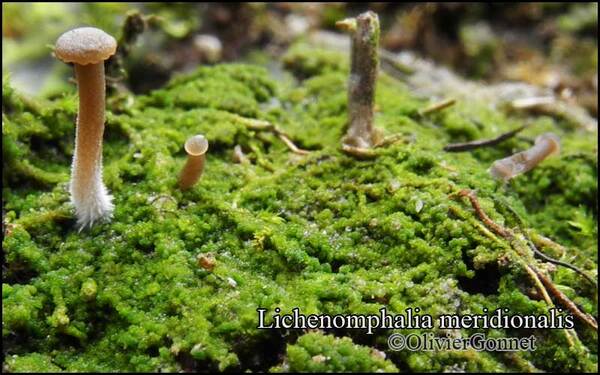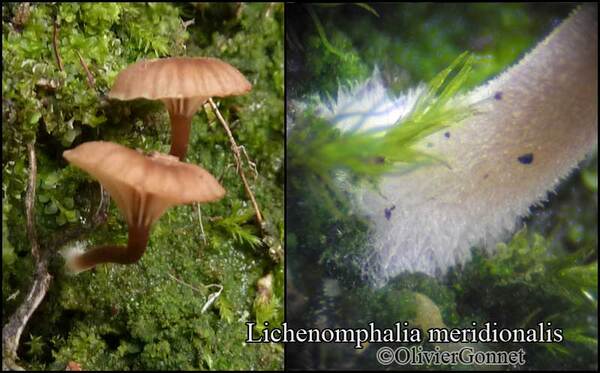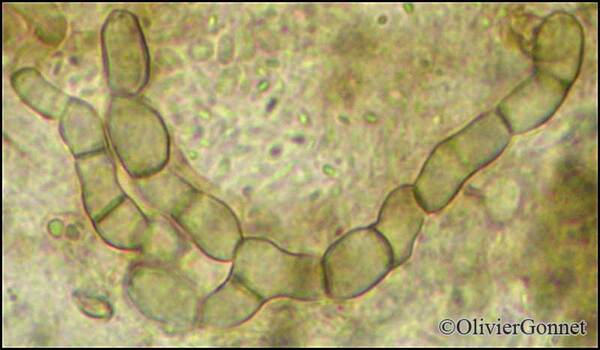Lichenomphalia meridionalis (Contu & La Rocca) P.-A. Moreau & Courtec.
Docum. Mycol., 34, 135: 50, 2008. Basionym: Omphalina meridionalis Contu & La Rocca - Fungi non Delineati, 9: 32-33, 1999.
Synonyms:
Distribution: C - Sar (Contu & La Rocca 1999, Barrasa & Esteve Raventós 2000, Barrasa & Rico 2001).
Description: Thallus crustose, episubstratic, forming a soft, gelatinous (when wet), green to dark green film made of 20-80 μm thick, globose granules consisting of clumps of algal cells incompletely surrounded by appressed pseudoparenchymatous hyphae with 5-12 μm thick angular cells. Clamp connections absent in all hyphae. Basidiocarps not lichenized, with a 3.5-9 mm wide, convex to omphaloid, yellowish red, pale brown to reddish yellow cap with sinuous, striate margins, thick, whitish, broadly decurrent lamellae, and a terete, 5-15 mm high, 0.6-1.2 mm thick, brown to dark brown, often minutely white-tomentose stipe. Pileipellis a cutis to subtrichodermium, suprapellis of cylindrical, 3-15 μm thick hyphae with cylindrical to clavate ends, the pigment in the subpellis slightly encrusting, never zebroid. Basidia clavate to subcylindrical, with (2-)4 sterigmata, 16-30 x 4.5-6 μm. Basidiospores 1-celled, hyaline, elongate to subcylindrical, (7-)7.5-11 x 4-6 μm, thin-walled, with a prominent apiculus, I-. Photobiont chlorococcoid (Coccomyxa). Spot tests: all negative. Chemistry: thallus without lichen substances.Note: a Mediterranean to Mediterranean-montane basidiolichen, also known from Japan, growing on acid soil, roadsides and opening of evergreen oak woodlands, often associated with Cistus-stands, to be looked for in other parts of Mediterranean Italy.
Growth form: Crustose
Substrata: soil, terricolous mosses, and plant debris
Photobiont: green algae other than Trentepohlia
Reproductive strategy: mainly sexual
Commonnes-rarity: (info)
Alpine belt: absent
Subalpine belt: absent
Oromediterranean belt: absent
Montane belt: absent
Submediterranean belt: absent
Padanian area: absent
Humid submediterranean belt: extremely rare
Humid mediterranean belt: extremely rare
Dry mediterranean belt: absent

Predictive model

Courtesy Danièle et Olivier Gonnet - Source: https://www.afl-lichenologie.fr/Photos_AFL/Photos_AFL_L/Texte_L_3/Lichenomphalia_meridionalis.htm
France, Plateau du Cuscionu - massif de l’Alcudina, Quenza, alt. 1600 m - Corse
26/10/2012

Courtesy Danièle et Olivier Gonnet - Source: https://www.afl-lichenologie.fr/Photos_AFL/Photos_AFL_L/Texte_L_3/Lichenomphalia_meridionalis.htm
France, Plateau du Cuscionu - massif de l’Alcudina, Quenza, alt. 1600 m - Corse
26/10/2012
Growth form: Crustose
Substrata: soil, terricolous mosses, and plant debris
Photobiont: green algae other than Trentepohlia
Reproductive strategy: mainly sexual
Commonnes-rarity: (info)
Alpine belt: absent
Subalpine belt: absent
Oromediterranean belt: absent
Montane belt: absent
Submediterranean belt: absent
Padanian area: absent
Humid submediterranean belt: extremely rare
Humid mediterranean belt: extremely rare
Dry mediterranean belt: absent

Predictive model

Courtesy Danièle et Olivier Gonnet - Source: https://www.afl-lichenologie.fr/Photos_AFL/Photos_AFL_L/Texte_L_3/Lichenomphalia_meridionalis.htm
France, Plateau du Cuscionu - massif de l’Alcudina, Quenza, alt. 1600 m - Corse
26/10/2012




